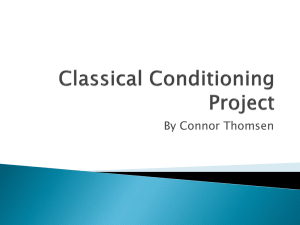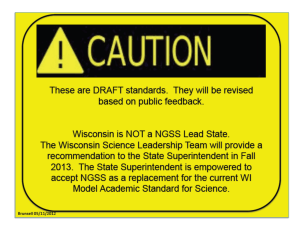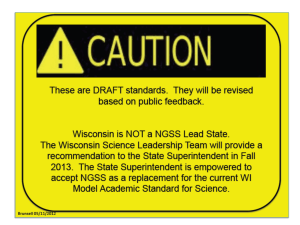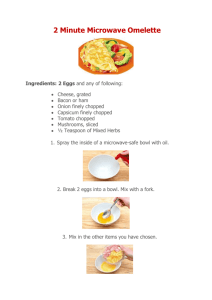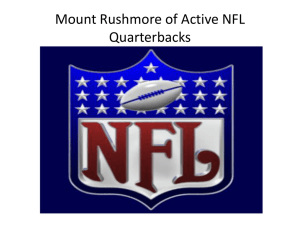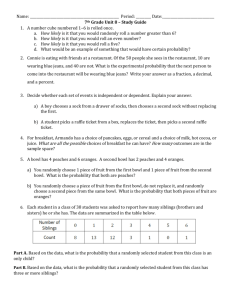3-ESS2 Earth`s Systems Students who
advertisement
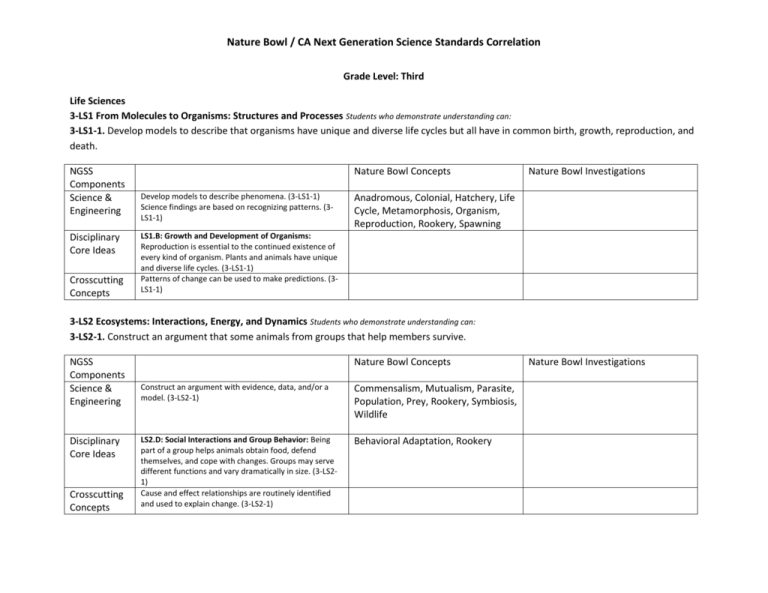
Nature Bowl / CA Next Generation Science Standards Correlation Grade Level: Third Life Sciences 3-LS1 From Molecules to Organisms: Structures and Processes Students who demonstrate understanding can: 3-LS1-1. Develop models to describe that organisms have unique and diverse life cycles but all have in common birth, growth, reproduction, and death. NGSS Components Science & Engineering Disciplinary Core Ideas Crosscutting Concepts Nature Bowl Concepts Develop models to describe phenomena. (3-LS1-1) Science findings are based on recognizing patterns. (3LS1-1) Nature Bowl Investigations Anadromous, Colonial, Hatchery, Life Cycle, Metamorphosis, Organism, Reproduction, Rookery, Spawning LS1.B: Growth and Development of Organisms: Reproduction is essential to the continued existence of every kind of organism. Plants and animals have unique and diverse life cycles. (3-LS1-1) Patterns of change can be used to make predictions. (3LS1-1) 3-LS2 Ecosystems: Interactions, Energy, and Dynamics Students who demonstrate understanding can: 3-LS2-1. Construct an argument that some animals from groups that help members survive. NGSS Components Science & Engineering Disciplinary Core Ideas Crosscutting Concepts Nature Bowl Concepts Construct an argument with evidence, data, and/or a model. (3-LS2-1) Commensalism, Mutualism, Parasite, Population, Prey, Rookery, Symbiosis, Wildlife LS2.D: Social Interactions and Group Behavior: Being part of a group helps animals obtain food, defend themselves, and cope with changes. Groups may serve different functions and vary dramatically in size. (3-LS21) Cause and effect relationships are routinely identified and used to explain change. (3-LS2-1) Behavioral Adaptation, Rookery Nature Bowl Investigations Nature Bowl / CA Next Generation Science Standards Correlation 3-LS3 Heredity: Inheritance and Variation of Traits Students who demonstrate understanding can: 3-LS3-1. Analyze and interpret data to provide evidence that plants and animals have traits inherited from parents and that variation of these traits exists in a group of similar organisms. 3-LS3-2. Use evidence to support the explanation that traits can be influenced by the environment. NGSS Components Science & Engineering Disciplinary Core Ideas Crosscutting Concepts Nature Bowl Concepts Analyze and interpret data to make sense of phenomena using logical reasoning. (3-LS3-1) Use evidence (e.g., observations, patterns) to support an explanation. (3-LS3-1) LS3.A: Inheritance of Traits Many characteristics of organisms are inherited from their parents. (3-LS3-1) Other characteristics result from individuals’ interactions with the environment, which can range from diet to learning. Many characteristics involve both inheritance and environment. (3-LS3-2) LS3.B: Variation of Traits Different organisms vary in how they look and function because they have different inherited information. (3LS3-1) The environment also affects the traits that an organism develops. (3-LS3-2) Patterns: Similarities and differences in patterns can be used to sort and classify neutral phenomena. (3-LS3-1) Cause and Effect: Cause and effect relationships are routinely identified and used to explain change. (3-LS32) Nature Bowl Investigations Abiotic/ Biotic Factors, Adaptation, Camouflage, Ecosystem, Environment, Habitat 3-LS4 Biological Evolution: Unity and Diversity Students who demonstrate understanding can: 3-LS4-1. Analyze and interpret data from fossils to provide evidence of the organisms and the environments in which they lived long ago. 3-LS4-2. Use evidence to construct an explanation for how the variations in characteristics among individuals of the same species may provide advantages in surviving, finding mates, and reproducing. 3-LS4-3. Construct an argument with evidence that in a particular habitat some organisms can survive well, some survive less well, and some cannot survive at all. Nature Bowl / CA Next Generation Science Standards Correlation 3-LS4-4. Make a claim about the merit of a solution to a problem when the environment changes and the types of plants and animals that live there may change. NGSS Components Science & Engineering Disciplinary Core Ideas Crosscutting Concepts Nature Bowl Concepts Analyze and interpret data to make sense of phenomena using logical reasoning. (3-LS4-1) Use evidence (e.g., observations, patterns) to construct an explanation. (3-LS4-2) Construct an argument with evidence. (3-LS4-3) Make a claim about the merit of a solution to a problem by citing relevant evidence about how it meets the criteria and constraints of the problem. (3-LS4-4) LS2.C: Ecosystem Dynamics, Functioning, and Resilience: When the environment changes in ways that affect a place’s physical characteristics, temperature, or availability of resources, some organisms survive and reproduce, others move to new locations, yet others move into the transformed environment, and some die. (3-LS4-4) LS4.A: Evidence of Common Ancestry and Diversity: Some kinds of plants and animals that once lived on Earth are no longer found anywhere. (3-LS4-1) Fossils provide evidence about the types of organisms that lived long ago and also about the nature of their environments. (3-LS4-1) LS4.B: Natural Selection: Sometimes the differences in characteristics between individuals of the same species provide advantages in surviving, finding mates, and reproducing. (3-LS4-2) LS4.C: Adaptation: For any particular environment, some kinds of organisms survive well, some survive less well, and some cannot survive at all. (3-LS4-3) LS4.D: Biodiversity and Humans: Populations live in a variety of habitats, and change in those habitats affects the organisms living there. (3-LS4-4) Cause and effect relationships are routinely identified and used to explain change. (3-LS4-2), (3-LS4-3) Observable phenomena exist from very short to very long time periods. (3-LS4-1) A system can be described in terms of its components Abiotic/ Biotic Factor, Adaptation, Camouflage, Carrying capacity, Competition, Environment, Exotic, Extinction, Habitat, Limiting factors, Microhabitat, Native, Niche Nature Bowl Investigations Nature Bowl / CA Next Generation Science Standards Correlation and their interactions (3-LS4-4) Science assumes consistent patterns in natural systems. (3-LS4-1) 3-ESS2 Earth’s Systems Students who demonstrate understanding can: 3-ESS2-1 Represent data in tables and graphical displays to describe typical weather conditions expected during a particular season. 3-ESS2-2 Obtain and combine information to describe climates in different regions of the world. NGSS Components Science & Engineering Disciplinary Core Ideas Crosscutting Concepts Nature Bowl Concepts Obtain and combine information from books and other reliable media to explain phenomena. (3-ESS2-2) Nature Bowl Investigations Abiotic Factor, Biotic Factor, Environment, Solar, Water cycle, Watershed, Weathering ESS2.D: Weather and Climate: Scientists record patterns of the weather across different times and areas so that they can make predictions about what kind of weather might happen next (3-ESS2-1) Climate describes a range of an area’s typical weather conditions and the extent to which those conditions vary over years. (3-ESS2-2) Patterns of change can be used to make predictions. (3ESS2-1), (3-ESS2-2) 3-ESS3 Earth and Human Activity Students who demonstrate understanding can: 3-ESS3-1. Make a claim about the merit of a design solution that reduces the impact of a weather-related hazard. NGSS Components Science & Engineering Disciplinary Core Ideas Nature Bowl Concepts Make a claim about the merit of a solution to a problem by citing relevant evidence about how it meets the criteria and constraints of the problem. (3-ESS3-1) ESS3.B: Natural Hazards: A variety of natural hazards result from natural processes. Humans cannot eliminate natural hazards but can take steps to reduce their Hydroelectric, Mitigate Nature Bowl Investigations Nature Bowl / CA Next Generation Science Standards Correlation impacts. (3-ESS3-1) Crosscutting Concepts Cause and effect relationships are routinely identified, tested, and used to explain change. (3-ESS3-1) Science affects everyday life. (3-ESS3-1). Grade Level: Fourth 4-LS1 From Molecules to Organisms: Structures and Processes Students who demonstrate understanding can: 4-LS1-1 Construct an argument that plants and animals have internal and external structures that function to support survival, growth, behavior, and reproduction. 4-LS1-2 Use a model to describe that animals receive different types of information through their senses, process the information in their brain, and respond to the information in different ways. NGSS Components Science & Engineering Disciplinary Core Ideas Crosscutting Concepts Nature Bowl Concepts Use a model to test interactions concerning the functioning of a natural system. (4-LS1-1) LS1.D: Information Processing Different sense receptors are specialized for particular kinds of information, which may be then processed by the animal’s brain. Animals are able to use their perceptions and memories to guide their actions. (4-LS1-2) A system can be described in terms of its components and their interactions. (4-LS1-1), (4-LS1-2) Adaptation, Exoskeleton Nature Bowl Investigations Nature Bowl / CA Next Generation Science Standards Correlation 4-ESS2 Earth’s Systems Students who demonstrate understanding can: 4-ESS2-1 Make observations and/or measurements to provide evidence of the effects of weathering or the rate of erosion by water, ice, wind, or vegetation. 4-ESS2-2 Analyze and interpret data from maps to describe patterns of Earth’s features. NGSS Components Science & Engineering Disciplinary Core Ideas Crosscutting Concepts Nature Bowl Concepts Make observations and/or measurements to produce data to serve as the basis for evidence for an explanation of a phenomenon. (4-ESS2-1) Analyze and interpret data to make sense of phenomena using logical reasoning. (4-ESS2-2) ESS2.A: Earth Material and Systems Rainfall helps to shape the land and affects the types of living things found in a region. Water, ice, wind, living organisms, and gravity break rocks, soils, and sediments into smaller particles and move them around. (4-ESS2-1) ESS2.E: Biogeology Living things affect the physical characteristics of their regions. (4-ESS2-1) Patterns can be used as evidence to support an explanation. (4-ESS2-2) Cause and effect relationships are routinely identified, tested, and used to explain change. (4-ESS2-1) Nature Bowl Investigations Abiotic Factor, Biotic Factor, Ecosystem, Erosion, Silt, Water cycle, Watershed, Weathering 4-ESS3 Earth and Human Activity Students who demonstrate understanding can: 4-ESS3-1 Obtain and combine information to describe that energy and fuels are derived from natural resources and their uses affect the environment. 4-ESS3-2 Generate and compare multiple solutions to reduce the impacts of natural Earth processes on humans. NGSS Components Science & Engineering Nature Bowl Concepts Obtain and combine information from books and other reliable media to explain phenomena. (4-ESS3-1) Alternative energy, Energy, Environment, Fossil fuel, Geothermal energy, Natural resource, Nonrenewable resource, Recycle, Nature Bowl Investigations Nature Bowl / CA Next Generation Science Standards Correlation Reduce, Renewable resource, Reuse, Solar Disciplinary Core Ideas Crosscutting Concepts ESS3.A: Natural Resources Energy and fuels that humans use are derived from natural sources, and their use affects the environment in multiple ways. Some resources are renewable over time, and others are not. (4-ESS3-1) ESS3.B: Natural Hazards A variety of hazards result from natural processes (e.g., earthquakes, tsunamis, volcanic eruptions). Humans cannot eliminate the hazards but can take steps to reduce their impacts. (4-ESS3-2) ETS1.B: Designing Solutions to Engineering Problems Testing a solution involves investigating how well it performs under a range of likely conditions. Over time, people’s needs and wants change, as do their demands for new and improved technologies. (4-ESS3-1) Grade Level: Fifth 5-LS1 From Molecules to Organisms: Structures and Processes Students who demonstrate understanding can: 5-LS1-1 Support an argument that plants get the materials they need for growth chiefly from air and water. NGSS Components Science & Engineering Nature Bowl Concepts Support an argument with evidence, data, or a model. (5-LS1-1) Abiotic Factor, Biotic Factor, Ecosystem, Energy, Food chain, Food web, Natural resource, Photosynthesis, Producers, Renewable resource, Solar Nature Bowl Investigations Nature Bowl / CA Next Generation Science Standards Correlation Disciplinary Core Ideas Crosscutting Concepts LS1.C: Organization for Matter and Energy Flow in Organisms Plants acquire their material for growth chiefly from air and water. (5-LS1-1) Matter is transported into, out of, and within systems. (5-LS1-1) 5-LS2 Ecosystems: Interactions, Energy, and Dynamics Students who demonstrate understanding can: 5-LS2-1 Develop a model to describe the movement of matter among plants, animals, decomposers, and the environment. NGSS Components Science & Engineering Disciplinary Core Ideas Nature Bowl Concepts Science explanations describe the mechanisms for natural events. (5-LS2-1) LS2.A: Interdependent Relationships in Ecosystems The food of almost any kind of animal can be traced back to plants. Organisms are related in food webs in which some animals eat plants for food and other animals eat the animals that eat plants. Some organisms, such as fungi and bacteria, break down dead organisms (both plants or plants parts and animals) and therefore operate as “decomposers.” Decomposition eventually restores (recycles) some materials back to the soil. Organisms can survive only in environments in which their particular needs are met. A healthy ecosystem is one in which multiple species of different types are each able to meet their needs in a relatively stable web of life. Newly introduced species can damage the balance of an ecosystem. (5-LS2-1) LS2.B: Cycles of Matter and Energy Transfer in Ecosystems Matter cycles between the air and soil and among plants, animals, and microbes as these organisms Abiotic Factor, Biotic Factor, Biodegradable, Carnivore, Carrion, Compost, Consumer, Decomposer, Ecosystem, Environment, Fertilizer, Food chain, Food web, Fungus, Herbivore, Inorganic, Niche, Organic, Omnivore, Parasite, Photosynthesis, Predator, Prey, Producers, Scavenger Nature Bowl Investigations Nature Bowl / CA Next Generation Science Standards Correlation Crosscutting Concepts live and die. Organisms obtain gases, and water, from the environment, and release waste matter (gas, liquid, or solid) back into the environment. (5-LS2-1) A system can be described in terms of its components and their interactions. (5-LS2-1) 5-ESS2 Earth’s Systems Students who demonstrate understanding can: 5-ESS2-1 Develop a model using an example to describe ways the geosphere, biosphere, hydrosphere, and/or atmosphere interact. 5-ESS2-2 Describe and graph the amounts and percentages of water and fresh water in various reservoirs to provide evidence about the distribution of water on Earth. NGSS Components Science & Engineering Disciplinary Core Ideas Nature Bowl Concepts Develop a model using an example to describe a scientific principle. (5-ESS2-1) ESS2.A: Earth Materials and Systems Earth’s major systems are the geosphere (solid and molten rock, soil, and sediments), the hydrosphere (water and ice), the atmosphere (air), and the biosphere (living things, including humans). These systems interact in multiple ways to affect Earth’s surface materials and processes. The ocean supports a variety of ecosystems and organisms, shapes landforms, and influences climate. Winds and clouds in the atmosphere interact with the landforms to determine patterns of weather. (5-ESS2-1) ESS2.C: The Roles of Water in Earth’s Surface Processes Nearly all of Earth’s available water is in the ocean. Most fresh water is in glaciers or underground; only a tiny Abiotic/ Biotic Factor, Aquatic, Aquifer, Biodiversity, Carrying capacity, Decomposer, Ecosystem, Environment, Food chain, Food web, Groundwater, Inorganic, Limiting factors, Microhabitat, Natural resource, Niche, Non-renewable resources, Organic, Photosynthesis, Producer, Renewable resource, Solar, Water cycle, Watershed Nature Bowl Investigations Nature Bowl / CA Next Generation Science Standards Correlation Crosscutting Concepts fraction is in streams, lakes, wetlands, and the atmosphere. (5-ESS2-2) A system can be described in terms of its components and their interactions. (5-ESS2-1) 5-ESS3 Earth and Human Activity Students who demonstrate understanding can: 5-ESS3-1 Obtain and combine information about ways individual communities use science ideas to protect the Earth’s resources and environment. NGSS Components Science & Engineering Disciplinary Core Ideas Crosscutting Concepts Nature Bowl Concepts Obtain and combine information from books and/or other reliable media to explain phenomena or solutions to a design problem. (5-ESS3-1) ESS3.C: Human Impacts on Earth Systems Human activities in agriculture, industry, and everyday life have had major effects on the land, vegetation, streams, ocean, air, and even outer space. But individuals and communities are doing things to help protect Earth’s resources and environments. (5-ESS3-1) Science findings are limited to questions that can be answered with empirical evidence. (5-ESS3-1) Alternative energy, Biodegradable, Bioenergy, Carbon Footprint, Compost, Conservation, Development, Ecosystem, Energy, Environment, Fertilizer, Fossil fuel, Geothermal energy, Groundwater, Greenhouse Gases, Habitat, Hydroelectric, Inorganic, Landfill, Litter, Mitigate, Natural resource, Non-renewable resource, Organic, Pesticide, Pollution, Product, Recycle, Reduce, Renewable resource, Restoration, Reuse, Solar, Sustainable Use, Toxic Waste, Nature Bowl Investigations Nature Bowl / CA Next Generation Science Standards Correlation 5-PS3 Energy Students who demonstrate understanding can: 5-PS3-1 Use models to describe that energy in animals’ food (used for body repair, growth, motion, and to maintain body warmth) was once energy from the sun. NGSS Components Science & Engineering Disciplinary Core Ideas Crosscutting Concepts Nature Bowl Concepts Use models to describe phenomena. (5-PS3-1) Nature Bowl Investigations Abiotic Factor, Biotic Factor, Carnivore, Energy, Food chain, Food web, Herbivore, Photosynthesis, Producer, Solar PS3.D: Energy in Chemical Processes and Everyday Life The energy released [from] food was once energy from the sun that was captured by plants in the chemical process that forms plant matter (from air and water). (5PS3-1) LS1.C: Organization for Matter and Energy Flow in Organisms Food provides animals with the materials they need for body repair and growth and the energy they need to maintain body warmth and for motion. Energy can be transferred in various ways and between objects. (5-PS3-1) Grade Level: Sixth MS-LS1 From Molecules to Organisms: Structures and Processes Students who demonstrate understanding can: MS-LS1-4 Use argument based on empirical evidence and scientific reasoning to support an explanation for how characteristic animal behaviors and specialized plant structures affect the probability of successful reproduction of animals and plants respectively. MS-LS1-5 Construct a scientific explanation for how environmental and genetic factors influence the growth of organisms. NGSS Components Nature Bowl Concepts Nature Bowl Investigations Nature Bowl / CA Next Generation Science Standards Correlation Science & Engineering Construct a scientific explanation based on valid and reliable evidence obtained from sources (including the students’ own experiments) and the assumption that theories and laws that describe the natural world operate today as they did in the past and will continue to do so in the future. (MS-LS1-5) Disciplinary Core Ideas LS1.B: Growth and Development of Organisms Animals engage in characteristic behaviors that increase the odds of reproduction. (MS-LS1-4) Plants reproduce in a variety of ways, sometimes depending on animal behavior and specialized features for reproduction. (MS-LS1-4) Genetic factors as well as local conditions affect the growth of the adult plant. (MS-LS1-5) Systems may interact with other systems; they may have sub-systems and be a part of larger complex systems. (MS-LS1-3) Crosscutting Concepts Adaptation, Anadromous, Biodiversity, Camouflage, Commensalism, Competition, Migration, Mutualism, Niche, Parasite, Reproduction, Spawning, Symbiosis MS-ESS2 Earth’s Systems Students who demonstrate understanding can: MS-ESS2-4 Develop a model to describe the cycling of water through Earth’s systems driven by energy from the sun and the force of gravity. NGSS Components Science & Engineering Disciplinary Core Ideas Nature Bowl Concepts Develop and use a model to describe phenomena. (MSESS2-6) ESS2.C: The Roles of Water in Earth’s Surface Processes Water continually cycles among land, ocean, and atmosphere via transpiration, evaporation, condensation and crystallization, and precipitation, as well as downhill flows on land. (MS-ESS2-4) The complex patterns of the changes and the movement of water in the atmosphere, determined by winds, landforms, and ocean temperatures and currents, are major determinants of local weather patterns. (MSESS2-5) Abiotic Factor, Biotic Factor, Aquifer, Erosion, Groundwater, Hydroelectric, Natural resource, Runoff, Solar, Water cycle, Watershed, Weathering Nature Bowl Investigations Nature Bowl / CA Next Generation Science Standards Correlation Global movements of water and its changes in form are propelled by sunlight and gravity. (MS-ESS2-4) Variations in density due to variations in temperature and salinity drive a global pattern of interconnected ocean currents. (MS-ESS2-6) ESS2.D: Weather and Climate Weather and climate are influenced by interactions involving sunlight, the ocean, the atmosphere, ice, landforms, and living things. These interactions vary with latitude, altitude, and local and regional geography, all of which can affect oceanic and atmospheric flow patterns. (MS-ESS2-6) Because these patterns are so complex, weather can only be predicted probabilistically. (MS-ESS2-5) The ocean exerts a major influence on weather and climate by absorbing energy from the sun, releasing it over time, and globally redistributing it through ocean currents. (MS-ESS2-6) Crosscutting Concepts Models can be used to represent systems and their interactions—such as inputs, processes and outputs— and energy, matter, and information flows within systems. (MS-ESS2-6) Within a natural or designed system, the transfer of energy drives the motion and/or cycling of matter. (MSESS2-4) MS-ESS3 Earth and Human Activity Students who demonstrate understanding can: MS-ESS3-3 Apply scientific principles to design a method for monitoring and minimizing a human impact on the environment. MS-ESS3-5 Ask questions to clarify evidence of the factors that have caused the rise in global temperatures over the past century. NGSS Components Science & Engineering Nature Bowl Concepts Ask questions to identify and clarify evidence of an argument. (MS-ESS3-5) Bioenergy, Carbon Dioxide, Carbon Climate Change, Carbon Footprint Ecosystem, Environment, Fossil fuel, Geothermal energy, Greenhouse Nature Bowl Investigations Nature Bowl / CA Next Generation Science Standards Correlation Gases, Hydroelectric, Litter, Nonrenewable resources, Renewable resources, Sustainable Use, Toxic Waste Disciplinary Core Ideas Crosscutting Concepts ESS3.C: Human Impacts on Earth Systems Human activities have significantly altered the biosphere, sometimes damaging or destroying natural habitats and causing the extinction of other species. But changes to Earth’s environments can have different impacts (negative and positive) for different living things. (MSESS3-3) ESS3.D: Global Climate Change Human activities, such as the release of greenhouse gases from burning fossil fuels, are major factors in the current rise in Earth’s mean surface temperature (global warming). Reducing the level of climate change and reducing human vulnerability to whatever climate changes do occur depend on the understanding of climate science, engineering capabilities, and other kinds of knowledge, such as understanding of human behavior and on applying that knowledge wisely in decisions and activities. (MS-ESS3-5) The use of technologies and any limitations on their use are driven by individual or societal needs, desires, and values; by the findings of scientific research; and by differences in such factors as climate, natural resources, and economic conditions. Thus technology use varies from region to region and over time. (MS-ESS3-3)

